Long time readers of the Kansas City Star and Times might remember a column by a woman named Mrs. Sam Ray. The columns always featured commentary and a reproduction of an old postcard from Mrs. Ray’s vast collection of cards. They were usually intricately colored historical images of noteworthy mansions, municipal buildings, industry and civic life of Kansas City.
Today, the cards live in the Missouri Valley Special Collections of the Kansas City Public Library and the library is staging an exhibit with them that opened Monday, January 28th.
The show is called “Greetings from Kansas City,” and Curator Eli Paul told Laura Ziegler he thinks Mrs. Sam Ray would be proud of the show. He says it shows the golden age of postcards, as well as the golden age of Kansas City.
EP: Thousands of people passed through the United States every day, and they needed a place to stay, so they went to the hotels downtown. They needed a place to shop so they went to some of the great department stores in our history. Postcards captured so many of those sites.
LZ: It was also a way to say ‘hey, look where I am!’ Cities were relatively new and people who came in from the countryside wanted to see the theaters, shopping and civic life. It was sort of a way to brag about where you were and where you were going.
EP: In fact that’s one of the themes of our exhibit. Looking at these postcards as an example of civic pride, not only pride by people who live in Kansas City, but also pieces of wonderment and amazement visitors to Kansas City were sending back home. It was Kansas City at its best, most exciting and most colorful.
LZ: One of the things about postcards – people tended to write in shorter sentences, sort of more clipped messages. Here’s one: “How is my boy? With love, Papa,” And there are others that reflect a change in writing style.
EP: This has been called by some “postcardese,” which means that it was almost a new way of communicating - abbreviated, abrupt sentences, sometimes switching from one top to another.
In fact, it was such a change from the letter writing of the Victorian era, that some people questioned whether Americans were losing their ability to write clearly.
LZ: Why does that sound so familiar?
EP: Well, it is quite familiar, and another reason why these types of messages really resonate today, because you can see you have a very small area in which to write your message, and you try to get across the most important points. You take shortcuts to do that, and they were doing this 100 years ago on the back of the penny postcard.
LZ: I want you to tell me about some of these beautiful old homes and neighborhoods.
EP: Now you get postcards of individual homes, sometimes a person’s own home, and start getting down to the idea of pride, in the sense of ‘look at us, we are very prosperous here!’
LZ: Here we are with hotels…..definitely some recognizable buildings. Here is a picture of The Aladdin Hotel downtown, again one of these buildings that was standing alone in the card but now is surrounded by other buildings and development. And The Savoy, were all those rooms in the hotel?
EP: All those were rooms. Kansas City was so dense in terms of the DT. So people were coming through Union Station, and they were funneled North where so many of the hotels were located, dozens and dozens of hotels and large hotels at that.
LZ: Here we are – Kansas City, ‘The Cow Town.’
EP: Yes, you can tell cow town was not a pejorative term at that time. There was a lot of pride with this, a lot of civic pride. We only had Chicago ahead in terms of the size of our stockyards and the amount of business we were doing in the livestock and food production area.
LZ: I heard there were 20,000 head of cattle that passed through the Kansas City Stockyards in those days.
EP: And how do we know that? That was on the back of a postcard that was sold and that showed the Kansas City stockyards teaming with dozens of pens filled with cattle. Also, it tells you what you are looking at – this was the view – and I’m reading off the card here- “of a portion of a cattle yard looking Southwest from the Livestock Exchange Building.” That was a great source of pride for city. It was finished in 1911 and had dozens and dozens of offices. It had its own post office, barbershop; it was a city within a city that handled all the needs of the people doing business down at the stock yards. It’s now on the historic register. It’s a very important building in the history of Kansas City.
LZ: Here we have a panel that reflects the related business of transportation – essentially rivers and trains.
EP: This started with the building of the Hannibal Bridge in 1869 which is the subject of a turn of the century postcard. When it opened up in 1869 it basically made possible the Kansas City stockyards. You can see Kansas City is so exquisitely located to take advantage of this new bridge, to take advantage of the Missouri River, and later on with Union Station becoming even more important as a rail road hub for the central part of the U.S.
LZ: Finally, I’m curious what we may have lost when we lost the art of writing postcards. Here we are in the age of Facebook and email and Twitter which is, particularly for our young people, their primary mode of communication.
EP: In some ways we may not have lost a lot. We are still sending messages with visuals. What I think we may have lost - is anyone going to be looking at our messages 100 years for now? Obviously on a piece of cardboard that has survived for a century we can look back at our ancestors and get a glimpse of their life, but are we going to be leaving that same type of message to future generations?












